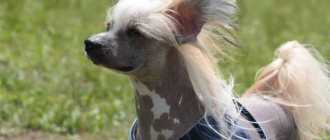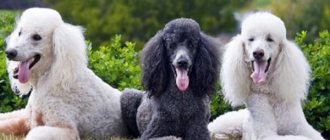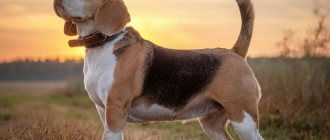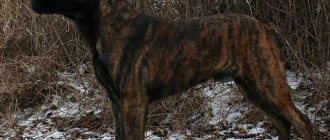The Bolognese or Italian lapdog is a small decorative dog. She is very charming, looks like a plush toy. These dogs are cheerful, sociable, friendly and affectionate. They can become a devoted companion for any owner. Suitable for adults and children, for the elderly, ideal for apartment living. But before you get an Italian lapdog, you need to study the description of the breed and care features. Reviews from the owners will help you learn about the pros and cons of the content.
- Head
- Upbringing
- Grooming
Breed traits
Breed traits (on a 5-point scale)
| Bolognese (Bolognese Bichon, Italian lap dog) | |||
| Activity | in the house | 4.1 | |
| on the street | 3.8 | ||
| Obedience | training | 4.4 | |
| strangers | 2.5 | ||
| Domination | in family | 3 | |
| over dogs | 2 | ||
| Defending your territory | from people | 2.7 | |
| from dogs | 2.4 | ||
| Sociability | in family | 5 | |
| with strangers | 3.2 | ||
| with dogs | 4.2 | ||
| Concentration | in family | 3 | |
| in front of strangers | 2.9 | ||
| with dogs | 2.7 | ||
| Aggressiveness | in family | 1 | |
| to strangers | 2 | ||
| to the dogs | 1.5 | ||
| to cats | 1.2 | ||
| Family behavior | calmness | 4 | |
| demand for affection | 4.8 | ||
| excitability | 3 | ||
| playfulness | 4.6 | ||
| excessive barking | 2.1 | ||
| behavioral breakdowns | 1.5 | ||
| Tolerance for children | up to 4 years | 3.6 | |
| over 4 years old | 3.8 | ||
| Institutional use | watchman | 1 | |
| bodyguard | 1 | ||
This breed is often compared to the following dog breeds: Bichon Frize, Shih Tzu, Toy Poodle, Maltese (Maltese Bichon), Yorkshire Terrier.
Photos of Bolognese dogs:
Health
The Bolognese or Italian lapdog is a naturally healthy animal. However, if not properly cared for or fed, the dog may become ill.
Diseases
The most common diseases:
- eye inflammation;
- blockage of the tear ducts;
- problems with eyelashes;
- food allergies;
- Tartar formation and gum inflammation;
- problems with the musculoskeletal system (subluxation).
Pets can become infected with worms. Once every three months the animal is given anti-helminth medications. Lapses may develop fleas. Bologneses become infected with these parasites during contact with other people's animals on the street.
Ticks pose a huge danger to dogs. Parasites live in grass and fallen leaves. Ticks are carriers of many diseases, and their bite can lead to the death of an animal.
Vaccinations
Pets are susceptible to many diseases: hepatitis, plague, rabies, leptospirosis, enteritis. Vaccines are considered a reliable means of combating diseases. Puppies must be vaccinated starting at two months of age. Only a veterinarian can give injections to dogs. At the time of vaccination, the animal must be absolutely healthy.
The first vaccination is complex. It is done against the most common diseases (rabies, plague, leptospirosis, enteritis, hepatitis). At first, the puppy is given only half of the vaccine. The second part is injected a month later. Revaccination is carried out every other year.
Before vaccination, the animal’s body is cleansed of helminths. The dog is not taken for a walk for several days before and after vaccination. During quarantine, they provide adequate nutrition. The pet is not allowed to swim or have contact with other animals.
Description of the Bolognese breed
The Bolognese dog breed was developed in Italy. Due to its external similarity, it is sometimes confused with the French lapdog (Bichon Frize). This happens especially often in Russia, perhaps because these dogs were brought to our country from France in the 18th century. But these are different breeds.
Bolognese is translated as “Bolognese dog”. The breed belongs to a group of lapdogs that are similar in appearance and character. The closest thing to the Bolognese is the Bichon Frize, which comes from France, the Maltese or Maltese, and the Madagascar Bichon. Other varieties of lapdogs may be larger and may be black or brown in color.
Italian lapdogs are the most popular representatives of decorative dogs. They are not only attractive, but also have a calm, friendly character, affectionate, and obedient. They are unpretentious, do not require complex care, have good health and a long life expectancy.
| Options | Characteristic |
| breed name | Bolognese, Italian lapdog, Bolognese bichon |
| country of origin | Italy |
| group of breeds according to the ICF classification | decorative and companion dogs, bichon section |
| application | companion |
| life expectancy | 13-15 years old |
| height | males 27-30 cm, females 25-28 cm |
| weight | 2.5-4 kg |
| character traits | friendly, devoted, affectionate, calm, obedient, cheerful |
| aggression | No |
| activity | average |
| intelligence | smart, quickly learn commands and various tricks |
| complexity of content | unpretentious, but difficult to care for |
pros
The Italian lapdog is a small, unpretentious dog. It quickly adapts to any conditions and lifestyle of the owner. Perfect for small apartments and inexperienced owners. Representatives of the breed have several other advantages:
- good-natured, not aggressive;
- love children and are patient with them;
- quickly find a common language with all family members;
- get along well with other pets;
- smart, quick-witted, easy to learn;
- do not need long walks;
- have good health;
- They shed little.
Minuses
But representatives of this breed also have disadvantages. This is a decorative dog, it will not become a watchman. Lapdogs are more expensive than other dogs and require serious coat care. Representatives of this breed have several more disadvantages:
- may be touchy;
- loneliness is too hard to bear;
- out of boredom they can bark loudly and spoil things;
- cowardly, afraid of loud noises.
Training and education
This dog is ready to do anything for treats and praise. She will carry out any command and do what the owner needs. The Maltese is easy to train and can be trained and educated without any problems. Only occasionally, some individuals who are too willful and independent show stubbornness and disobedience. However, you can find an approach to them and teach basic commands.
Literally after the first lesson, when the dog understands that he will receive a treat for following this or that command, he will fulfill all your requirements even more diligently. It is not necessary to hire a specialist to train it.
When raising a Maltese, it is important to understand that oppression, excessive cruelty and aggression can provoke a response. The pet will grow up to be too cruel and uncontrollable; bites from pets and the owner are possible
In addition, he will be disappointed in people, which is unacceptable, because by their nature these animals are soft and gentle creatures.
History of the origin of the Bolognese breed
Italian Bologneses are the result of crossing Maltese dogs and miniature poodles. That’s why they have such an unusual appearance: curly, soft, white fur with a thick undercoat. The breed received its name from the province of Bologna, where it was bred.
In the XII-XVII centuries, these dogs became popular companions for noble ladies. They were attractive, non-aggressive and obedient. They were often depicted in paintings by famous artists. A dog of this breed was a valuable gift for any nobleman. It was fashionable to keep it; it was evidence of high social status.
But these miniature dogs were also popular for exterminating rats. Sailors often took them with them on the ship - they did not take up much space, brightened up monotonous everyday life and reduced the number of rats.
In the 18th century, the popularity of the Bolognese Bichon decreased, and the number of these dogs decreased greatly. In Europe, ordinary people began to own this breed. At that time they began to spread in other countries and became popular in France. The French ambassador gave a Bolognese puppy to Catherine II. Since that time in Russia these dogs have been called French lapdogs. The Bolognese breed was officially recognized in 1955, and the final standard was adopted in 1995.
Historical reference
The first mention of the Italian Bolognese dog dates back to the 12th century. Dogs can be seen in the paintings of famous painters of that time.
The Bolognese is a descendant of Bichons and Poodles, which are common in southern Italy. The name comes from the Italian city of Bologna, where the breed was bred.
At the beginning of the 20th century, there were less than a dozen representatives of the breed left in the world. Breeders from Europe were able to restore it with great effort.
Appearance Standards
The Bolognese Bichon is a small, stocky dog with a strong, proportional build. The average height at the withers is 28-30 cm, weight is about 4 kg. Because of its fluffy long hair, the dog resembles a snowball or a plush children's toy.
Head
The head is round, medium in size, proportional to the body. The muzzle is small, the occipital protuberance is well defined. The forehead is flat, the stop is sharp, the bridge of the nose is straight. The jaws are well developed, strong, and have a scissor bite. The nose is large and should be black.
The eyes are round, large, and set wide apart. They should be dark in color and not convex. The ears are long and drooping. At the base they are hard, slightly raised, the rest of the ear tissue is soft and hangs down. The ears are covered with long hair. This makes the head appear larger and more round.
Frame
The physique is strong, harmonious, square in shape. The chest is wide, the stomach is moderately tucked. The back is straight, the loin is convex, the croup is wide. The tail continues the line of the back. It is of medium length, covered with long hair, carried over the back or curled into a ring.
Limbs
Limbs are straight, muscular, of medium length. The fur makes them appear shorter. The forelimbs are parallel, the elbows are pressed to the chest. The thighs are muscular, the hock joints are almost not pronounced. The paws are oval, the toes are collected, the pads are dense and dark. The dog moves easily and freely. The gait is energetic and he runs fast.
Coat and color
The coat is thick, fluffy, with a dense undercoat. It is not smooth, but a little wavy, so it puffs up. It is very pleasant and silky to the touch. It is short in the area of the muzzle, long on the rest of the body. The color according to the standard should be snow-white. In some individuals it may be cream, yellowish or grayish. The presence of tan or dark spots is a serious fault.
Photos complement the description of the appearance of Bolognese:
Character of Italian lapdogs
These dogs were bred as decorative companions. Therefore, they are people-oriented. Bologneses are friendly, not aggressive, and will never bite or snap. They are affectionate and sociable. Feel the mood of the owner.
Lapdogs become very attached to their owner and get bored when alone. They love to sit on their hands. These dogs are not very active and do not require long walks, making them ideal pets for older people. But they are cheerful, playful, and can become the best friend for a child or active young man.
Thanks to their small size, representatives of this breed are easy to take with you on any trip. They fit into a bag and are easily adapted to any conditions. Bologneses are ready for anything, the main thing is that their beloved owner is nearby.
These dogs love children and are friendly and patient with them. They will never offend a child or show aggression. It is better not to leave small children alone with them - the dog itself may suffer. And for a school-age child, this dog will become the best friend. Bologneses get along calmly with other pets, never enter into conflicts, do not fight for primacy and are not jealous.
These dogs are very sensitive, responsive, and emotional. In response to attention, they give their owner a lot of love. They love to be petted, held, and praised. If the Bichon feels indifference, lack of care and attention, he will feel sad and may become depressed.
Upbringing
Despite the fact that these Italian lapdogs are a decorative breed, these dogs also need training. Many owners believe that they do not need to be trained because they will not become service dogs or guard dogs. But it is still necessary to teach the basic rules of behavior and socialize the puppy from an early age. This will save you from many problems in the future and make the dog obedient.
From an early age, the puppy needs to be accustomed to strangers, the noise of cars, and introduced to other dogs. Then the adult dog will not be timid and fearful.
Training should be done in the form of a game. Classes must be regular and consistent. You need to communicate with the puppy in a calm tone, the main method of education is encouragement. Rudeness and physical punishment should not be used. With the right approach, a dog of this breed is easy to teach:
- immediately respond to a nickname;
- know your place and go there when ordered;
- walk nearby on a leash;
- know the order “you can’t”;
- follow the commands “sit” and “stand”.
Bolognese can also be easily taught various tricks. These dogs often perform in the circus. They walk on their hind legs, tumble, bark on command, and fetch objects.
Upbringing
Sometimes owners of decorative dogs confuse concepts such as training and education. These are two completely different processes that require a specific approach. Puppies are trained from the age of six months, and education must be done from birth, or more precisely, from the moment a furry pet appears in your home.
Many owners note that after visiting the nursery they got the impression that these babies were raised from birth. This statement is true, but only partly. Probably, the aristocratic upbringing of Bolognese’s ancestors has an effect. Modern representatives of the breed understand perfectly well from the first time what is allowed and what should not be done under any circumstances. Therefore, it is enough to strictly reprimand the child once for a mistake, and he will never repeat it again.
In the process of education, you should completely abandon screaming and the “whip” method. You will achieve better results if you praise your little one for her successes.
Features of keeping Italian lapdogs
The Italian lap dog is ideal for keeping in an apartment, even a small one. These small dogs are unpretentious and can be easily trained to use a diaper or litter tray to go to the toilet. After all, in severe frost or bad weather it is better not to go outside with them. But you still need to walk these dogs, 2 times a day for 30-40 minutes. Longer walks and greater physical activity are not advisable - representatives of this breed are not adapted to them.
You need to give your lapdog a cozy place at home, preferably in a house. They like to hide in a secluded place. The house must be placed away from drafts and heating devices.
Hygiene procedures for lap dogs are simple: keep your eyes and ears clean, brush your teeth and trim your nails every week. To prevent tartar, you can give special bones from the veins. The eyes need to be given special attention, as they are often irritated by long hair. If discharge appears, brown tracks will form.
Grooming
This dog's coat and thick undercoat require regular grooming. It needs to be combed out daily, preferably after a walk, as blades of grass, twigs and debris get stuck in it. The coat is very soft and gets tangled quickly. For combing, a comb with long rounded teeth is used. If a tangle has formed, it is easier to untangle it with your hands using a special balm.
Many owners cut their pet's hair. In addition to hygienic shortening of the fur on the paws and under the tail, there are different options for cutting lap dogs:
- like a puppy;
- under a teddy bear;
- in Japanese style.
Show dogs are not cut, as this spoils the structure of the coat. The only possible hygienic haircut is to shorten the hair under the tail and on the paws. But they need to be brushed more often. Before the exhibition, it is better to contact a specialist for professional grooming.
You should not bathe your dog often; 1-2 times a month is enough. Be sure to use shampoo for long-haired dogs with conditioner. It is advisable that it is intended for white wool, this will prevent it from yellowing. After every walk you need to wash your paws and belly. You can take your pet outside in overalls, then he will get less dirty. After eating, you need to wash your face; dirt will quickly turn your mustache and beard brown.
The photo shows how to care for the coat and what haircuts you can make:
Nutrition
Representatives of this breed are unpretentious in food and have a good appetite. They also don’t move much and are prone to weight gain. Therefore, it is important to choose the right diet for your dog so that he does not overeat.
When choosing dry food, you should give preference to super-premium or holistic class options with a minimal content of carbohydrates and fats. The food should be hypoallergenic, as representatives of this breed are prone to allergies. Conveniently, the prepared food is balanced in terms of nutrients. Dry croquettes can be alternated with canned food of the same brand.
With natural feeding, the diet consists of the following products:
- lean meat - at least half of the daily diet;
- offal;
- low-fat cottage cheese and kefir;
- porridge – rice, buckwheat, oatmeal;
- stewed or boiled vegetables;
- fresh fruits, herbs.
It is recommended to add a drop of vegetable oil to food and periodically give vitamin and mineral supplements. Foods from the human table, fatty, spicy, salty are prohibited. You should not give baked goods, confectionery, sweets, potatoes, legumes, or poultry bones.
Food should be at room temperature. It is recommended to feed 2-3 times a day in small portions. Clean water should always be freely available.
Health
With good care, dogs of this breed can live 15-17 years. They have fairly good health, congenital pathologies are rare. The teeth require special attention - lap dogs are prone to the formation of tartar, as well as the eyes, which are irritated by long hair. Sometimes the following diseases occur:
- hip dysplasia;
- dislocation of the kneecap;
- allergy;
- eye diseases;
- obesity;
- indigestion;
- dermatitis.
To keep your dog healthy, you need to get all the necessary vaccinations on time. Give anthelmintic drugs 4 times a year. During the warm season, the coat must be treated against fleas and ticks.
Special care for show Maltese
If you are purchasing a Maltese to show the dog, we advise you to thoroughly take care of the fur from the first days the puppy lives in the house. You will need to wash it more often, once a week. After washing and pre-drying, you should wrap the white fur in curlers; teach the dog from an early age. To prevent the lapdog from removing his curlers, the dog is dressed in a special silk jumpsuit. Curling is required so that the coat grows thick and long, without splitting. showed an even structure.
Shampoos should not be used to wash human hair. You need to choose a good shampoo for Maltese and conditioner from a similar company. You cannot cut off tangles and tangles. If the wool is too tangled after washing, you will need to sort it out with your fingers while it is still wet. With constant combing and grooming, tangling problems will not arise.
Popular articles When kittens start eating themselves
It is important to add healthy vegetable fats and vitamins A and E to the show dog’s diet, which add shine to the coat. It is permissible to mix fish oil, flax seed and other useful ingredients into the porridge.
How to buy a Bolognese Bichon puppy
You can only purchase a purebred lapdog from a nursery or from a responsible breeder. Before purchasing, it is recommended to study the living conditions of the animals, meet the mother, and communicate with the owner. It is important that you have all the necessary documents and veterinary certificates.
In Moscow, a purebred puppy can be bought for 30-40 thousand rubles. The offspring of exhibition winners are more expensive, the price for them reaches 70-80 thousand rubles. It is not recommended to buy a dog secondhand or at the market; there is a risk that it will be sick or not purebred.
When choosing a puppy, you need to pay attention to its color so that there are no dark spots. The paws should be straight, the gait should be confident, the nose should be black. A healthy puppy has no discharge from the ears and eyes, hair without dandruff and bald spots. The nose is wet, there is no unpleasant smell. And the behavior is active, playful.
Photos of Bolognese puppies:
The video complements the characteristics of the Bolognese dog breed:
Video: Italian lapdog (Bolognese, Bolognese bichon) - all about the breed through the eyes of the owner
The Italian lapdog is a decorative miniature dog. Thanks to her cheerful, outgoing nature, she can become the best friend of both a child and any adult. This dog will not only decorate the house with its attractive appearance, but will also make life more fun and will not let you get bored.
Owner reviews
Bolognese is a dog whose reviews are extremely positive. The owners cannot name a single disadvantage of these babies. Four-legged pets are naturally endowed with a soft and flexible character, are not vindictive, are always cheerful, easily get along with all pets, are smart, and subtly sense the mood of the owner.
Perhaps the only drawback of the Italian lapdog is its high price. But this question fades into the background as soon as you see these dogs in the kennel. No one can resist their charm. That is why all visitors to nurseries leave with a fluffy white lump in their hands.











